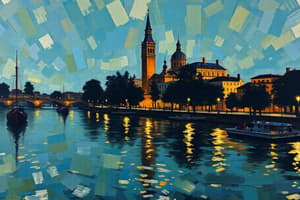Podcast
Questions and Answers
Which of the following statements best describes the impact of transport technology on holiday-taking between 1850 and 1945?
Which of the following statements best describes the impact of transport technology on holiday-taking between 1850 and 1945?
- Transport innovations primarily affected urban tourism over rural tourism.
- Transport technology made holiday-taking more exclusive to affluent classes.
- Improvements in transport technology increased the speed and accessibility of travel. (correct)
- The introduction of steamships reduced the number of destinations available.
Which 'push' factor is commonly associated with motivating people to go on holidays?
Which 'push' factor is commonly associated with motivating people to go on holidays?
- Cultural attractions in the destination.
- Desire to escape daily routine and stress. (correct)
- Affordability of travel packages.
- Social interactions at the holiday destination.
Which of the following is essential for the effective functioning of a tourist destination?
Which of the following is essential for the effective functioning of a tourist destination?
- Well-maintained infrastructure and transport links. (correct)
- Diverse recreational activities available to visitors.
- A high tourist season with limited accommodations.
- A strong local cuisine that matches national trends.
What role does air transport play in the tourism industry?
What role does air transport play in the tourism industry?
Which of the following statements is true regarding the tourism industry's impact on the environment?
Which of the following statements is true regarding the tourism industry's impact on the environment?
Flashcards are hidden until you start studying
Study Notes
Advances in Transport Technology (1850-1945)
- Introduction of railways significantly reduced travel time, enabling mass tourism.
- Development of steamships opened transatlantic travel, making international holidays accessible.
- Invention of the automobile democratized travel, offering flexibility and personal freedom.
- Air travel emerged post-World War I, transforming long-distance vacations by mid-20th century.
- Advances in transport infrastructure, such as roads and airports, facilitated ease of access to destinations.
- Increased connectivity led to a rise in popular resort areas and travel industries.
Motivations for Holiday Taking
- Push Factors: elements that drive individuals to seek vacation, e.g., stress relief, desire for adventure, escape from routine.
- Pull Factors: attractions that draw tourists, such as cultural experiences, natural beauty, and recreational opportunities.
- Social influences, including peer recommendations and social media, can enhance the attractiveness of potential holiday destinations.
- Economic factors, including disposable income and travel costs, impact the decision to go on holidays.
Essential Factors for Destination Functionality and Visitor Experience
- (a) Effective Functioning of a Destination:
- Robust infrastructure including transportation, accommodation, and services.
- Unique attractions that cater to diverse tourist interests and demographics.
- Effective marketing strategies to promote the destination and highlight its features.
- (b) Positive Visitor Experiences:
- Quality of visitor services which includes friendliness and professionalism of staff.
- Safety and security measures, assuring tourists of a worry-free stay.
- Opportunities for engagement and interaction with local culture enhance satisfaction.
Integral Role of Transport in Tourism
- Focus on air travel as a mode of transport.
- Air transport connects remote and international destinations, broadening tourist reach.
- Quick journeys reduce time spent traveling, allowing for longer stays at destinations.
- Airlines often offer package deals that include accommodations and activities, boosting local economies.
- Innovations in air travel technology, such as jumbo jets, increased passenger capacity, making travel more affordable.
Positive Environmental Impacts of Tourism
- Sustainable tourism practices promote conservation and responsible travel behaviors.
- Ecotourism focuses on environmentally-friendly excursions, raising awareness of conservation efforts.
- Tourism revenue can fund conservation projects and facilities to protect natural habitats.
- Examples include national parks where entrance fees support maintaining biodiversity and ecosystems.
- Community engagement through tourism can lead to sustainable local development, enhancing environmental stewardship.
Studying That Suits You
Use AI to generate personalized quizzes and flashcards to suit your learning preferences.




